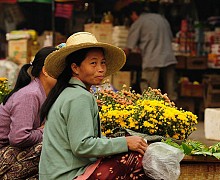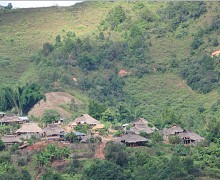In the uttermost east of Myanmar, nestled at 3,000 feet in a valley of green rice fields ringed by wooded hills, lies Kyaing Tong (Keng Tung), considered by some people to be the most scenic and atmospheric town in the country. It is an ancient town, continuously inhabited for 800 years or more by the Shan, the Khun and the Thai Lue peoples who still today comprise the majority of the area’s population. It is a crossroads of cultural exchange and of trade, both licit and illicit. In addition to its proximity to Thailand, Kyaing Tong lies a mere two-hour drive to the Chinese border crossing at Monglar, or to the Mekhong River, with Laos on its opposite bank.
Kyaing Tong is also, despite its ancestry, a small town, built around a small lake, and dotted with aging Buddhist temples and crumbling colonial architecture. The town is easily explored on foot, and to wander its curved and dusty streets is to take a journey back in time. At night, with twinkling stars clearly visible overhead even in the downtown areas and with plaintive guitar music drifting through the streets, there is a mediaeval feel to the town. By day, lacquerware and silver artisans ply their trade in its roadside shops, and its markets are a daily festival of abundant produce and ethnic diversity. Its soil is fertile, with flowers blooming in abundance in the gardens of the town, and a wide variety of fruit orchards lying around its perimeter, as well as rubber plantations.
The hills around the town are home to Akha, Wa and Lahu people, as well as the majority Shan people of the region. Many treks are possible to their villages, in the hill country leading to the Chinese and Lao borders, and these can be of several hours or several days duration. In the recent past much of this hill country was an insurgent area, off limits to foreigners; those days now are gone, the hills are planted with tea, and buyers from China are frequently encountered. The Akha men encountered in the hills will most commonly be seen with a homemade musket slung across their shoulders, and perhaps with a rabbit or game bird dangling from their belt. In many of the Thai Lue villages, communities still live in longhouses, each with its own cooking and sleeping area partitioned off by dangling cloth, while pigs and chickens forage below the house. In these longhouses tea and meat are cured and cheroots are smoked; a clear day is one with visibility from one end of the house to the other.
Shan Language
Shan, rather than Burmese, remains the lingua franca of the area today, heard everywhere on the streets of the town and in the surrounding villages. The Thai Lueare Shan people have a script of their own, while the Khun speak a Northern Thai language related to Shan and use a script similar to the ancient Lanna script of Chiang Mai in northern Thailand. Throughout most of its history as the capital of an independent kingdom, Kyaing Tong has seen neighbouring empires rise and fall and foreign armies and colonial powers come and go, perhaps even today harbouring dreams of its former glory.
Festivals
Kyaing Tong’s elevation spares it from the worst of the summer heat, while its winters are mild compared with the more mountainous regions of Shan State. The Shan New Year, usually falling in early December, is celebrated in a big way in Kyaing Tong, with festivals of song and dance, talent shows and beauty competitions. The Burmese New Year of Thingyan, in April, is also celebrated with enthusiasm. In Kyaing Tong this celebration includes a three-day "beating of the drum" in which the young men of the town, fuelled by local spirit, beat on an ancient drum of buffalo hide: the ceremony climaxes with the drum being carried in procession to a nearby shallow river, where most of the population, from matrons to monks, plunge into the waters and douse each other with wild abandon.





